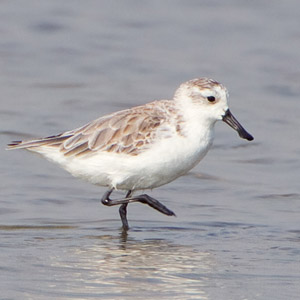Magazine | Études
Le Bécasseau spatule menacé par la chasse au Myanmar

Bécasseau spatule (Eurynorhynchus pygmeus).Photographie : JJ Harrison / Wikimedia Commons
Introduction
Le Bécasseau spatule (Eurynorhynchus pygmeus) n’a jamais été commun, mais sa population, estimée à environ 6 000 oiseaux dans les années 1970, serait tombée en 2009 entre 120 et 220 couples. L’espèce serait menacée aussi bien par la modification de ses sites de nidification de Sibérie orientale que par la chasse et par la destruction de ses zones de migration et d’hivernage.
En 2008 et 2009, des expéditions ont été menées au Myanmar (Birmanie), un pays essentiel pour l’hivernage de ce limicole.
En janvier 2010, une équipe internationale composée de Christoph Zöckler (ArcCona Consulting), Tony Htin Hla (Biodiversity and Nature Conservation Association of Myanmar), Nigel Clark (British Trust for Ornithology), Evgeny Syroechkovskiy (Birds Russia), Nicolay Yakushev (Birds Russia), Suchart Daengphayon (Bird Conservation Society Thailand) et Rob Robinson (British Trust for Ornithology) y a réalisé des études supplémentaires pour mieux comprendre l’impact de la chasse sur le déclin rapide de l’espèce, et un article synthétisant les inquiétants résultats obtenus a été publié en 2010 dans le Wader Study Group Bulletin (Waderstudygroup.org). Nous vous en proposons une version française.
Abstract
The rapid decline of the Spoon-billed Sandpiper Eurynorhynchus pygmeus population has led to a series of expeditions to locate the species’ main wintering areas. Surveys conducted in Myanmar during 2008–2010 showed an estimated wintering population of over 200, which is probably more than half the world population. Within Myanmar, the key estuary is the Bay of Martaban.
In Jan 2010, an international survey team conducted further studies of Spoonbilled Sandpipers in this country. They found extensive evidence of the hunting of waders in all sites visited, mostly by the poorest people in each village.
The majority of 26 bird-hunters questioned in 15 villages on the east side of the Bay of Martaban knew of Spoon-billed Sandpipers and most probably catch the species every year. Spoon-billed Sandpipers are not the hunters’ primary target but, along with other calidrids tend to be caught more frequently in the mist nets they use for other target species, such as Pacific Golden Plover Pluvialis fulva and Eurasian Curlew Numenius arquata.
It is likely that hunting in the wintering area is the major cause of the species’ decline, which may have been exacerbated by the fact that the Spoon-billed Sandpiper’s core wintering area happens to be an area of high hunting pressure. Urgent action is needed to find ways to give the local hunters economic alternatives to hunting. An awareness campaign will also help to persuade hunters to release Spoon-billed Sandpipers they catch. It is also vitally important to protect the habitats of the Bay of Martaban for its large waterbird populations. Without urgent conservation action we believe that the Spoon-billed Sandpiper will become extinct within 10–20 years.
We propose you a French version of the original article « Hunting in Myanmar is probably the main cause of the decline of the Spoon-billed Sandpiper Calidris pygmeus » published in 2010 in the Wader Study Group Bulletin (Waderstudygroup.org).
Poursuivez la lecture de cet article, en vous abonnant dès maintenant !
Découvrez les Archives d’Ornithomedia.com
Pour seulement 10,00 €TTC/an (ou 6,00 € les 6 mois)
Profitez de plusieurs centaines d’articles en accès illimité et sans aucun engagement.
Compléments
À lire sur le web
- Le site web du Wader Study Group : www.waderstudygroup.org
- Le site web « Saving the Spoon-billed Sandpiper » : www.saving-spoon-billed-sandpiper.com/
Ouvrages recommandés
- A Field Guide to the Birds of Thailand de Craig Robson
- A Photographic Guide to Birds of Thailand de Michael Webster, Chew Yen Fook
- Birds of Myanmar de Kyaw Nyunt Lwin (Auteur), Khin Ma Ma Thwin (Auteur), Aung Thant (Illustrations)
- A Field Guide to the Birds of South-East Asia de Craig Robson (30 janvier 2009)
Source
Zöckler C., Htin Hla T., Clark N., Syroechkovskiy E., Yakushev N., Daengphayon, S. & Robinson R. (2010). Hunting in Myanmar is probably the main cause of the decline of the Spoon-billed Sandpiper Calidris pygmeus. Wader Study Group Bull. 117(1): 1–8.




Aucun commentaire sur ce sujet
Participer à la discussion !